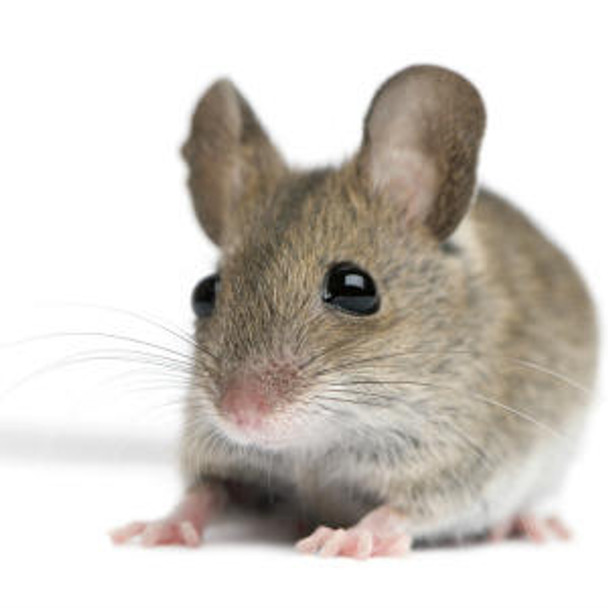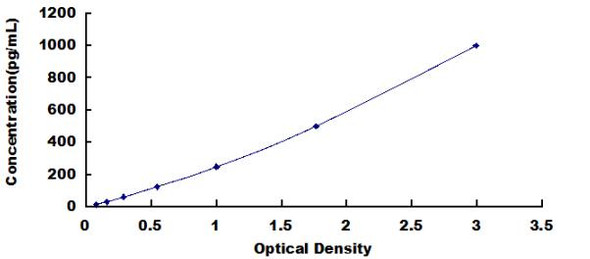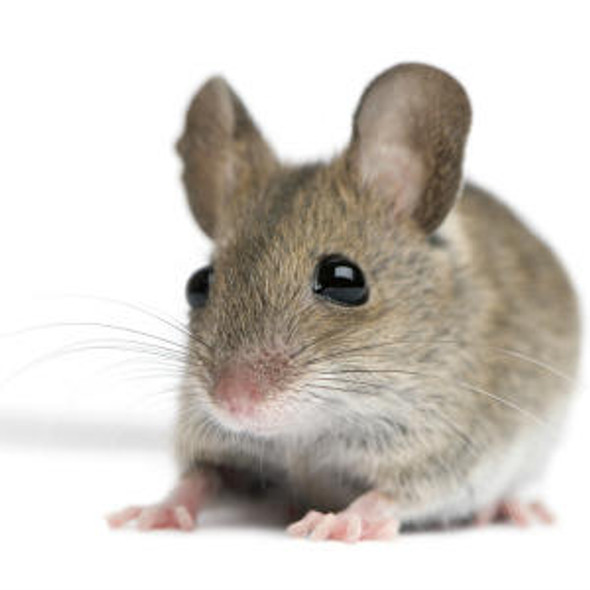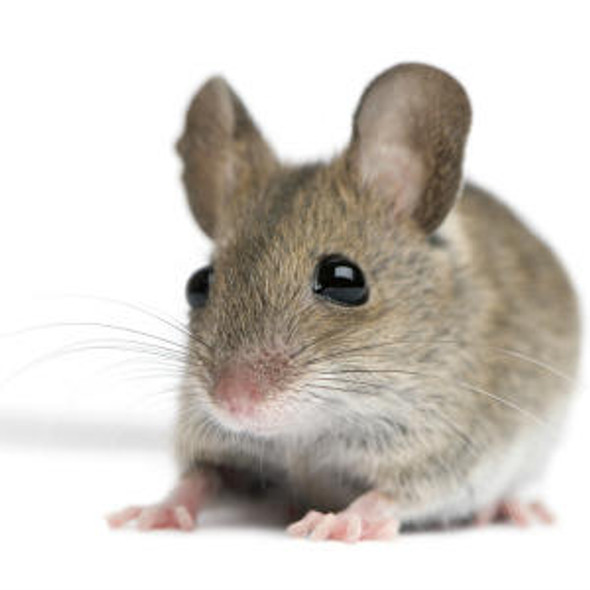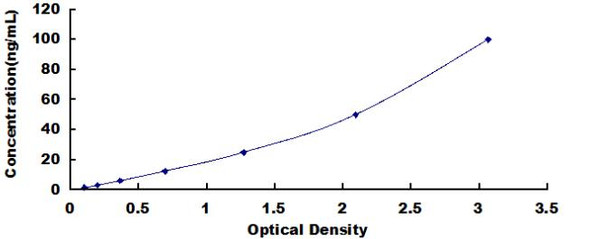Mouse B-cell lymphoma/leukemia 10 (Bcl10) ELISA Kit (MOEB2426)
- SKU:
- MOEB2426
- Product Type:
- ELISA Kit
- Size:
- 96 Assays
- Uniprot:
- Q9Z0H7
- ELISA Type:
- Sandwich
- Reactivity:
- Mouse
Description
Mouse B-cell lymphoma/leukemia 10 (Bcl10) ELISA Kit
The Mouse B-Cell Lymphoma/Leukemia-10 (Bcl10) ELISA Kit is specifically designed for the accurate measurement of Bcl10 levels in mouse samples including serum, plasma, and cell culture supernatants. This kit offers high sensitivity and specificity, ensuring precise and reproducible results for a variety of research applications.Bcl10 is a key protein involved in B-cell lymphoma and leukemia, playing a critical role in the regulation of cell proliferation and apoptosis.
Dysregulation of Bcl10 has been linked to various cancers and autoimmune diseases, making it an important target for research and potential therapeutic interventions.With its reliable performance and broad research applications, the Mouse B-Cell Lymphoma/Leukemia-10 (Bcl10) ELISA Kit is an invaluable tool for studying the mechanisms underlying B-cell lymphoma and leukemia, as well as for identifying new potential therapeutic strategies.
| Product Name: | Mouse B-cell lymphoma/leukemia 10 (Bcl10) ELISA Kit |
| SKU: | MOEB2426 |
| Size: | 96T |
| Target: | Mouse B-cell lymphoma/leukemia 10 (Bcl10) |
| Synonyms: | B-cell CLL/lymphoma 10, CARD-containing molecule enhancing NF-kappa-B, CARD-like apoptotic protein, CED-3/ICH-1 prodomain homologous E10-like regulator, Cellular homolog of vCARMEN, Cellular-E10, Mammalian CARD-containing adapter molecule E10, Bcl-10, mCLAP, mCIPER, cCARMEN, c-E10, mE10, Ciper, Clap |
| Assay Type: | Sandwich |
| Detection Method: | ELISA |
| Reactivity: | Mouse |
| Detection Range: | 0.156-10ng/mL |
| Sensitivity: | 0.084ng/mL |
| Intra CV: | 7.0% | ||||||||||||||||||||
| Inter CV: | 8.6% | ||||||||||||||||||||
| Linearity: |
| ||||||||||||||||||||
| Recovery: |
| ||||||||||||||||||||
| Function: | Involved in adaptive immune response. Promotes apoptosis, pro-caspase-9 maturation and activation of NF-kappa-B via NIK and IKK. May be an adapter protein between upstream TNFR1-TRADD-RIP complex and the downstream NIK-IKK-IKAP complex. Is a substrate for MALT1. |
| Uniprot: | Q9Z0H7 |
| Sample Type: | Serum, plasma, tissue homogenates, cell culture supernates and other biological fluids |
| Specificity: | Natural and recombinant mouse B-cell lymphoma/leukemia 10 |
| Sub Unit: | Found in a membrane raft complex, at least composed of BCL10, CARD11, DPP4 and IKBKB. Self-associates by CARD-CARD interaction and interacts with other CARD-proteins such as CARD9, CARD10, CARD11 and CARD14. Binds caspase-9 with its C-terminal domain. Interacts with TRAF2 and BIRC2/c-IAP2 (By similarity). Interacts with PELI2 and SOCS3; these interactions may be mutually exclusive. |
| Research Area: | Cancer |
| Subcellular Location: | Cytoplasm Membrane raft Colocalized with DPP4 in membrane rafts. |
| Storage: | Please see kit components below for exact storage details |
| Note: | For research use only |
| UniProt Protein Function: | Bcl-10: a ubiquitous pro-apoptotic protein that promotes pro-caspase-9 maturation and activation of NF-kappa-B via NIK and IKK. May be an adapter protein between upstream TNFR1-TRADD-RIP complex and the downstream NIK-IKK-IKAP complex. Self-associates via CARD-CARD interactions; forms a tight complex with MALT1. Interacts with other CARD-proteins such as CARD9, CARD10, CARD11 and CARD14. Binds caspase-9 with its C-terminal domain. Interacts with TRAF2 and BIRC2/c-IAP2. Defects in BCL10 are involved in various types of cancer. |
| UniProt Protein Details: | Protein type:Transcription, coactivator/corepressor; Tumor suppressor; Apoptosis Cellular Component: CBM complex; protein complex; lysosome; immunological synapse; cytosol; lipid raft; T cell receptor complex; membrane; cytoplasmic microtubule; perinuclear region of cytoplasm; cytoplasm; lipopolysaccharide receptor complex; intracellular; nucleus Molecular Function:protein C-terminus binding; protein kinase B binding; ubiquitin binding; protein homodimerization activity; protein self-association; protease binding; transcription coactivator activity; caspase activator activity; protein kinase binding; transcription factor binding; NF-kappaB binding; protein binding; enzyme binding; protein heterodimerization activity; ubiquitin protein ligase binding; kinase activator activity; kinase binding Biological Process: cell death; response to fungus; I-kappaB kinase/NF-kappaB cascade; protein heterooligomerization; positive regulation of apoptosis; apoptosis; positive regulation of transcription, DNA-dependent; positive regulation of caspase activity; B cell apoptosis; T cell receptor signaling pathway; mast cell activation; activation of JNK activity; activation of NF-kappaB transcription factor; regulation of apoptosis; negative regulation of mature B cell apoptosis; protein homooligomerization; response to food; caspase activation; adaptive immune response; immune system process; positive regulation of interleukin-8 biosynthetic process; protein oligomerization; positive regulation of protein ubiquitination; regulation of T cell receptor signaling pathway; neural tube closure; cellular defense response; immunoglobulin mediated immune response; positive regulation of T cell activation; positive regulation of phosphorylation |
| UniProt Code: | Q9Z0H7 |
| NCBI GenInfo Identifier: | 6753166 |
| NCBI Gene ID: | 12042 |
| NCBI Accession: | NP_033870.1 |
| UniProt Secondary Accession: | Q9Z0H7,Q3UBN4, |
| UniProt Related Accession: | Q9Z0H7 |
| Molecular Weight: | 25,948 Da |
| NCBI Full Name: | B-cell lymphoma/leukemia 10 |
| NCBI Synonym Full Names: | B cell leukemia/lymphoma 10 |
| NCBI Official Symbol: | Bcl10 |
| NCBI Official Synonym Symbols: | CLAP; ME10; cE10; CIPER; BCL-10; C81403; CARMEN; AI132454 |
| NCBI Protein Information: | B-cell lymphoma/leukemia 10 |
| UniProt Protein Name: | B-cell lymphoma/leukemia 10 |
| UniProt Synonym Protein Names: | B-cell CLL/lymphoma 10; Bcl-10; CARD-containing molecule enhancing NF-kappa-B; CARD-like apoptotic protein; mCLAP; CED-3/ICH-1 prodomain homologous E10-like regulator; mCIPER; Cellular homolog of vCARMEN; cCARMEN; Cellular-E10; c-E10; Mammalian CARD-containing adapter molecule E10; mE10 |
| Protein Family: | B-cell lymphoma/leukemia |
| UniProt Gene Name: | Bcl10 |
| UniProt Entry Name: | BCL10_MOUSE |
| Component | Quantity (96 Assays) | Storage |
| ELISA Microplate (Dismountable) | 8×12 strips | -20°C |
| Lyophilized Standard | 2 | -20°C |
| Sample Diluent | 20ml | -20°C |
| Assay Diluent A | 10mL | -20°C |
| Assay Diluent B | 10mL | -20°C |
| Detection Reagent A | 120µL | -20°C |
| Detection Reagent B | 120µL | -20°C |
| Wash Buffer | 30mL | 4°C |
| Substrate | 10mL | 4°C |
| Stop Solution | 10mL | 4°C |
| Plate Sealer | 5 | - |
Other materials and equipment required:
- Microplate reader with 450 nm wavelength filter
- Multichannel Pipette, Pipette, microcentrifuge tubes and disposable pipette tips
- Incubator
- Deionized or distilled water
- Absorbent paper
- Buffer resevoir
*Note: The below protocol is a sample protocol. Protocols are specific to each batch/lot. For the correct instructions please follow the protocol included in your kit.
Allow all reagents to reach room temperature (Please do not dissolve the reagents at 37°C directly). All the reagents should be mixed thoroughly by gently swirling before pipetting. Avoid foaming. Keep appropriate numbers of strips for 1 experiment and remove extra strips from microtiter plate. Removed strips should be resealed and stored at -20°C until the kits expiry date. Prepare all reagents, working standards and samples as directed in the previous sections. Please predict the concentration before assaying. If values for these are not within the range of the standard curve, users must determine the optimal sample dilutions for their experiments. We recommend running all samples in duplicate.
| Step | |
| 1. | Add Sample: Add 100µL of Standard, Blank, or Sample per well. The blank well is added with Sample diluent. Solutions are added to the bottom of micro ELISA plate well, avoid inside wall touching and foaming as possible. Mix it gently. Cover the plate with sealer we provided. Incubate for 120 minutes at 37°C. |
| 2. | Remove the liquid from each well, don't wash. Add 100µL of Detection Reagent A working solution to each well. Cover with the Plate sealer. Gently tap the plate to ensure thorough mixing. Incubate for 1 hour at 37°C. Note: if Detection Reagent A appears cloudy warm to room temperature until solution is uniform. |
| 3. | Aspirate each well and wash, repeating the process three times. Wash by filling each well with Wash Buffer (approximately 400µL) (a squirt bottle, multi-channel pipette,manifold dispenser or automated washer are needed). Complete removal of liquid at each step is essential. After the last wash, completely remove remaining Wash Buffer by aspirating or decanting. Invert the plate and pat it against thick clean absorbent paper. |
| 4. | Add 100µL of Detection Reagent B working solution to each well. Cover with the Plate sealer. Incubate for 60 minutes at 37°C. |
| 5. | Repeat the wash process for five times as conducted in step 3. |
| 6. | Add 90µL of Substrate Solution to each well. Cover with a new Plate sealer and incubate for 10-20 minutes at 37°C. Protect the plate from light. The reaction time can be shortened or extended according to the actual color change, but this should not exceed more than 30 minutes. When apparent gradient appears in standard wells, user should terminatethe reaction. |
| 7. | Add 50µL of Stop Solution to each well. If color change does not appear uniform, gently tap the plate to ensure thorough mixing. |
| 8. | Determine the optical density (OD value) of each well at once, using a micro-plate reader set to 450 nm. User should open the micro-plate reader in advance, preheat the instrument, and set the testing parameters. |
| 9. | After experiment, store all reagents according to the specified storage temperature respectively until their expiry. |
When carrying out an ELISA assay it is important to prepare your samples in order to achieve the best possible results. Below we have a list of procedures for the preparation of samples for different sample types.
| Sample Type | Protocol |
| Serum | If using serum separator tubes, allow samples to clot for 30 minutes at room temperature. Centrifuge for 10 minutes at 1,000x g. Collect the serum fraction and assay promptly or aliquot and store the samples at -80°C. Avoid multiple freeze-thaw cycles. If serum separator tubes are not being used, allow samples to clot overnight at 2-8°C. Centrifuge for 10 minutes at 1,000x g. Remove serum and assay promptly or aliquot and store the samples at -80°C. Avoid multiple freeze-thaw cycles. |
| Plasma | Collect plasma using EDTA or heparin as an anticoagulant. Centrifuge samples at 4°C for 15 mins at 1000 × g within 30 mins of collection. Collect the plasma fraction and assay promptly or aliquot and store the samples at -80°C. Avoid multiple freeze-thaw cycles. Note: Over haemolysed samples are not suitable for use with this kit. |
| Urine & Cerebrospinal Fluid | Collect the urine (mid-stream) in a sterile container, centrifuge for 20 mins at 2000-3000 rpm. Remove supernatant and assay immediately. If any precipitation is detected, repeat the centrifugation step. A similar protocol can be used for cerebrospinal fluid. |
| Cell culture supernatant | Collect the cell culture media by pipette, followed by centrifugation at 4°C for 20 mins at 1500 rpm. Collect the clear supernatant and assay immediately. |
| Cell lysates | Solubilize cells in lysis buffer and allow to sit on ice for 30 minutes. Centrifuge tubes at 14,000 x g for 5 minutes to remove insoluble material. Aliquot the supernatant into a new tube and discard the remaining whole cell extract. Quantify total protein concentration using a total protein assay. Assay immediately or aliquot and store at ≤ -20 °C. |
| Tissue homogenates | The preparation of tissue homogenates will vary depending upon tissue type. Rinse tissue with 1X PBS to remove excess blood & homogenize in 20ml of 1X PBS (including protease inhibitors) and store overnight at ≤ -20°C. Two freeze-thaw cycles are required to break the cell membranes. To further disrupt the cell membranes you can sonicate the samples. Centrifuge homogenates for 5 mins at 5000xg. Remove the supernatant and assay immediately or aliquot and store at -20°C or -80°C. |
| Tissue lysates | Rinse tissue with PBS, cut into 1-2 mm pieces, and homogenize with a tissue homogenizer in PBS. Add an equal volume of RIPA buffer containing protease inhibitors and lyse tissues at room temperature for 30 minutes with gentle agitation. Centrifuge to remove debris. Quantify total protein concentration using a total protein assay. Assay immediately or aliquot and store at ≤ -20 °C. |
| Breast Milk | Collect milk samples and centrifuge at 10,000 x g for 60 min at 4°C. Aliquot the supernatant and assay. For long term use, store samples at -80°C. Minimize freeze/thaw cycles. |

